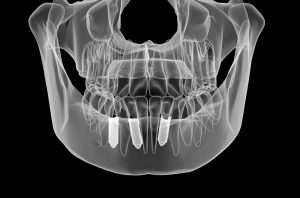
If you are missing one tooth or an entire arch of teeth, there are a variety of restorative procedures available to refurbish your smile, including dental implants and conventional dental bridges and overdentures. Dental implants are one of the most highly preferred methods. These small screw-like fixtures are designed to mimic the natural tooth roots and act as an anchor for a customized restoration, such as a dental crown, bridge, or implant-supported denture. The implant is strategically placed so it osseointegrates (fuses) with the natural jawbone to create a firm foundation.
The success rate of your dental implant is dependent on the position and number of implants used. Since the launch of dental implants in the 1950s, the science and technology behind placing dental implants has significantly progressed. Dentists today are able to provide accurate results and high success rates using cone beam technology.
Read on to learn more about cone beam technology, or contact Fresno Dental Scan by calling 559-297-6823.
What is Cone Beam Technology?
Cone beam scanning, also known as cone beam computed tomography (CBCT), is a three-dimensional form of digital x-ray technology that can capture detailed images of your teeth, gums, nerves, and jawbone in a matter of seconds. Images are immediately uploaded to a nearby computer that uses specialized software to create a three-dimensional model of your mouth. At Fresno Dental Scan, Dr. Denes uses both the Gendex CBCT 500 and Planmeca Planscan intraoral scanner together to create a comprehensive dental implant treatment plan in order to provide accurate results.
How is it Used for Treatment Planning?
Once the images are uploaded and the lifelike model of your mouth created, the doctor will carefully review images with you and customize the placement of your dental implants to your unique needs. Dental implants are unique in that if you are missing an entire row of teeth, you don’t need an implant to replace each tooth. Because of strategic placement, a full arch denture can be supported with just four to six dental implants.
Cone beam scanning allows the doctor to virtually plan each dental implant placement plan using specialized software in order to determine the best location based on the strength of your jawbone. If any bone loss has occurred, he will immediately be able to identify the issue and recommend a preliminary procedure, such as bone grafting or sinus lift, to strengthen your jawbone. According to the American Academy of Oral and Maxillofacial Radiology, cone beam technology is the preferred imaging method of choice for providing accurate dental implant assessment.
Once the treatment plan is established, a surgical guide is then fabricated that will rest directly on your teeth and gums, with access holes to assist the dentist in performing precise dental implant surgery. Guided implant surgery eliminates any guesswork from the process, ensuring the success rate of your dental implants. After you have fully recovered from dental implant surgery, and the implants have fused with your jawbone, your smile will be restored with a customized implant-supported device.
Contact Us to Learn More
If you are interested in learning more about dental implant treatment planning with cone beam scanning and intraoral digital technology, contact our Fresno, CA, practice today online or by calling 559-297-6823 to schedule your consulta